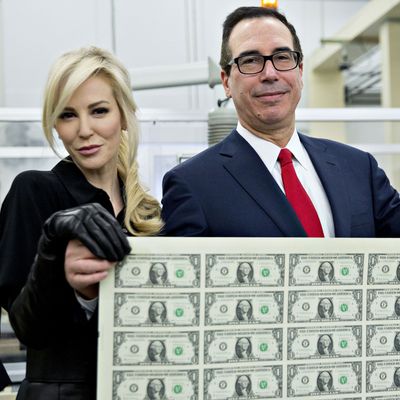
Republicans in Congress have spent weeks insisting their tax-cut plan would increase rather than decrease tax revenue, the findings of every credible budget estimate notwithstanding. Yesterday, the Treasury Department published an “analysis” purporting to support the Republican claim. The document, one page long, consisted of restating its assumption that the tax cuts — in combination with other, as-yet-unwritten bills to reduce social spending and increase infrastructure — would increase growth enough to pay for itself. It does not show how the tax cuts, or the tax cuts plus all the rest of Trump’s ideas, would produce the growth rate it assumes.
The fiscal defense of the Trump tax cuts is a failure even on its own, Alice in Wonderland-ish terms. If your plan only pays for itself when its effects are combined with the effects of other pieces of legislation, it does not pay for itself. Especially if the other legislation doesn’t exist. It’s like claiming for months you can beat up the toughest kid in school, then finally backing up the boast by describing a hypothetical fight where you beat him up with the aid of your black-belt cousin, when in fact your cousin’s grasp of martial arts has not advanced beyond an intention to enroll in a karate class at the YMCA.
And yet, as cartoonish as the fantasies of the Republican voodoo economists have been, they have succeeded in the most important respects: They persuaded their party’s entire political class that the tax-cut bill will not increase the deficit. And merely by causing the rest of us to refute the silly claims that the tax cuts will fail to lose revenue, it has shoved out of the public eye a much more plausible outcome: that the tax cuts will not lose zero revenue, or less revenue than forecast, but actually more. Possibly much more.
Why would the tax cuts lose even more revenue than forecast? Because the design is a sieve. Thirteen top tax lawyers studied the House and Senate versions of the tax cuts, and produced a 35-page analysis laying out the various loopholes and games the bill would open up. It is shot through with opportunities for individuals and businesses to make paper changes that would create opportunities for huge savings. Listing all the dodges they found would be as boring as — well, a list of financial maneuvers written by a bunch of tax lawyers. The upshot is that it’s a big list.
And the cost of all these maneuvers could add up. “The complex rules proposed in the House and Senate bills will allow new tax games and planning opportunities for well-advised taxpayers, which will result in unanticipated consequences and costs,” the lawyers write. “These costs may not currently be fully reflected in official estimates already showing the bills adding over $1 trillion to the deficit in the coming decade.”
Some of the opportunities are obvious even to non-tax lawyers: The pass-through loophole, which allows independent businesses to enjoy a tax rate up to 50 percent lower than they would now, will be irresistible. “Expect the best-paid dentists to turn into corporations so that they can take advantage of the new 20 percent corporate tax rate, instead of having to pay a top marginal rate of nearly 40 percent on some of their income,” predicts Patricia Cohen in the New York Times. “Look for a wave of promotions as staff lawyers on salary suddenly turn into partners to qualify for the 23 percent deduction the Senate bestowed on pass-through businesses.”
The law anticipates blue-state taxpayers handing hundreds of billions of dollars in additional tax revenue to Washington because the state income tax will no longer be fully deductible. But, as lawyer Eugene Volokh suggests, they could evade the penalty by switching to a payroll tax. That simple evasion would make the revenue gains disappear.
The Joint Committee on Taxation, which measured the fiscal cost of the bills, can’t be blamed if its studies misfire badly. It was operating under impossible conditions, estimating a bill that was being scrawled in haste. The last major tax reform began in 1984 and was signed into law in 1986. This process took a few weeks. No agency could have detected all the potential for tax evasion littered through hundreds of pages.
One tax-policy expert, who is hesitant to attach her name to such a rough estimate, told me, “Based on gut and sense of just how sloppily this thing has been drafted, I would think in the hundreds of billions. I’ve never seen such bad federal tax legislative drafting as some of the parts of this bill.” It’s difficult to guess the accuracy of a revenue forecast of a tax bill when people are eyeballing obvious ways to game it and publishing them in the newspaper before it’s even signed into law.
It is worth mentioning that, if these maneuvers flourish as expected, not only would the tax cuts hemorrhage far more revenue than expected, the unexpected windfall would accrue almost entirely to the rich. That means the Trump tax cuts will wind up even more heavily weighted toward the affluent than current measures forecast.
What Congress is prepared to pass is not tax reform. It is tax un-reform. Republicans are injecting the tax code with innumerable opportunities for people who have good accountants to avoid the nominal income tax rates. It’s hard to model the effect of something like this on the budget, because it’s hard to find any good examples of something quite so shoddy and corrupt.
Republicans have insisted the JCT forecast’s that the tax cut will lose $1 trillion in revenue is untrustworthy. “There’s no doubt that the JCT has been consistently underestimating the activity in our economy,” complains Republican senator Tim Scott. But what if the JCT is underestimating the activity of the tax-loophole industry?






























